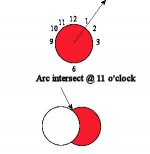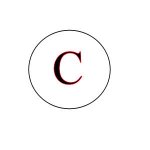Ok here is one that I have been working on...
Look down on the object ball and picture a clock face on the ball. On the very bottom (contact point for a straight in shot) is 6 o'clock. Determine which path you want the object ball to go. Then figure the opposite time.. example... if you want the ball to go in a 1 o'clock path then the opposite time would be eleven. Now get behind the cueball and line it up so that where the arcs of the cueball and object ball intersect is equal to the opposite time you determined before... the picture explains what i mean...
Look down on the object ball and picture a clock face on the ball. On the very bottom (contact point for a straight in shot) is 6 o'clock. Determine which path you want the object ball to go. Then figure the opposite time.. example... if you want the ball to go in a 1 o'clock path then the opposite time would be eleven. Now get behind the cueball and line it up so that where the arcs of the cueball and object ball intersect is equal to the opposite time you determined before... the picture explains what i mean...


